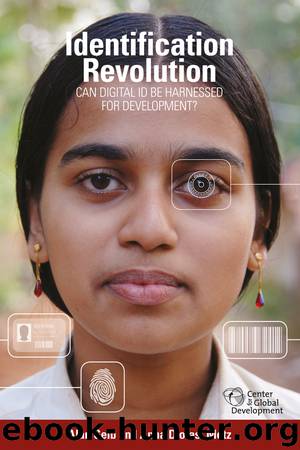Identification Revolution by Alan Gelb & Anna Diofasi Metz

Author:Alan Gelb & Anna Diofasi Metz
Language: eng
Format: epub
Publisher: Center for Global Development
FIVE
Confronting the Risks
While robust identification systems can help achieve many development outcomes, they can also give rise to a number of risks or exacerbate existing vulnerabilities. Most have been flagged in earlier chapters but have not been considered in an integrated way. This chapter provides an overview with an emphasis on risks relating to development impact. It does not consider specialized technical issues of data protection or the production of secure documents. Rather, it focuses on how ID systems can be applied in ways that run counter to the aspirations of the Sustainable Development Goals—or waste, rather than conserve, valuable resources—and how to mitigate the risks of such adverse applications. It is helpful to group the many different varieties of risks into three categories: exclusion risk, privacy risk, and cost risk.
Regarding the first category, exclusion risk, the formalization of identification through stronger systems may exclude vulnerable individuals or groups from participation in social and economic life or from essential services. They may be excluded because they are poor and deterred by the fees and charges required to enroll in the system or to use it to access services or benefits; they may also need assistance to navigate new technologies and approaches. Women or members of particular groups, such as ethnic minorities or remote communities, can face particularly large difficulties in accessing and using the system. A large but undetermined number of people face discriminatory exclusion from opportunities, services, or benefits when more rigorous identification is associated with the determination of national status.
The second category, privacy risk, is the possibility that personal data collected by identification systems may be misused to track the activities of individuals, invade their privacy, or steal their identities. This is not to say that advanced digital ID systems are inherently antithetical to privacy. In some circumstances, digital technology can be a less intrusive way to deliver benefits or services than traditional approaches. Also, identification is only one aspect of the digital revolution that is sweeping through rich and poor countries alike and raising other, more serious risks to privacy. The risks are likely higher in poor countries, however, because of the more limited stage of data privacy and protection laws as well as weaker systems of political checks and balances.
The third category of risks concerns the cost-effectiveness of large investments in identification systems. Even though there is mounting evidence that investing in a robust ID system can yield a high rate of return in a developing country context, the field is littered with cases of wasted investments and low-productivity programs. Some problems lie on the supply side—failures in strategy or design, or corrupt procurements that create redundant systems or boost the costs of acquiring technology. In other cases, the limiting factors lie in the demand for the use of the system. Even well-conceived investments in ID systems will fail to be productive if they are not used in appropriate ways, including to support the SDGs, whether because of implementation failures or because powerful vested interests block their most productive uses.
Download
This site does not store any files on its server. We only index and link to content provided by other sites. Please contact the content providers to delete copyright contents if any and email us, we'll remove relevant links or contents immediately.
Hit Refresh by Satya Nadella(8870)
The Compound Effect by Darren Hardy(8530)
Change Your Questions, Change Your Life by Marilee Adams(7389)
Nudge - Improving Decisions about Health, Wealth, and Happiness by Thaler Sunstein(7262)
The Black Swan by Nassim Nicholas Taleb(6786)
Deep Work by Cal Newport(6592)
Daring Greatly by Brene Brown(6233)
Rich Dad Poor Dad by Robert T. Kiyosaki(6196)
Principles: Life and Work by Ray Dalio(5991)
Man-made Catastrophes and Risk Information Concealment by Dmitry Chernov & Didier Sornette(5674)
Playing to Win_ How Strategy Really Works by A.G. Lafley & Roger L. Martin(5535)
Digital Minimalism by Cal Newport;(5398)
Big Magic: Creative Living Beyond Fear by Elizabeth Gilbert(5362)
The Myth of the Strong Leader by Archie Brown(5249)
The Slight Edge by Jeff Olson(5205)
Discipline Equals Freedom by Jocko Willink(5160)
The Motivation Myth by Jeff Haden(5011)
Stone's Rules by Roger Stone(4875)
The Laws of Human Nature by Robert Greene(4794)
